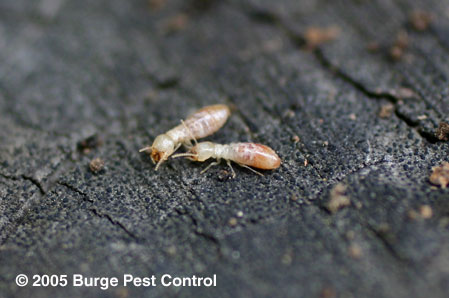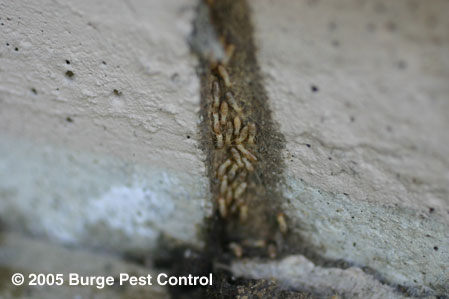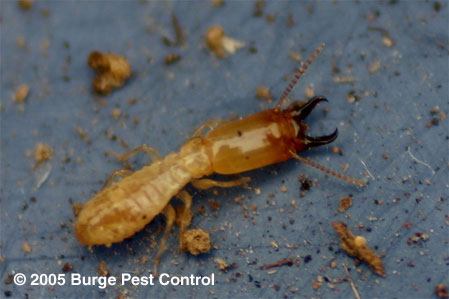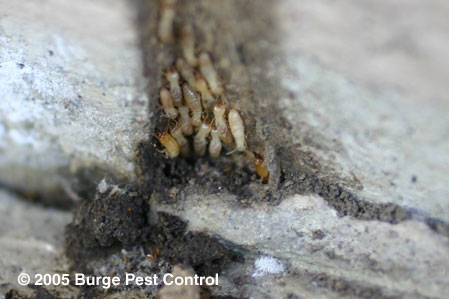 |
WESTERN SUBTERRANEAN TERMITE
The western subterranean termite is native to America. Of the three major subterranean termites species in the United States, this is the least aggressive. However, there can be multiple colonies per property and they still cause millions of dollars of damage to the Bay Area each year.
|
 |
These colonies can have as many as 300,000 individuals with multiple queens. Secondary colonies can be found inside homes if there is a constant source of moisture.
|
 |
As with most social insects there is a caste system. It consists of a queen, king, winged reproductives (young queens and kings), soldiers and the workers. Each playing a vital role to the colony.
|
|
Queens are the largest members of the colony. They can be found in a chamber deep in the soil or in walls next to a constant moisture source. Each queen can live up to 25 years and produce more than 2,000 eggs a day. It takes over five months for termites to go from eggs to adults.
|
 |
The workers are the largest caste in the colony. They are creamy tan about 1/8 inch long.The workers are in charge of gathering food (wood and other cellulose), grooming each other,building and repairing tunnels. They also feed and care for the queen, the king, all soldiers and nymphs (young).
|
 |
All workers in the colony are sterile females, blind and work almost constanlly throughout their two to five year lifespan.
|
 |
The soldiers are the defenders of the colony. Around 1/8 inch, they have an orangish retangular head with mandibulate pinchers. Their primary enemy are ants. Soldiers are also sterile females.
|
 |
If a shelter tube or the wood they are in is opened, soldiers will rush to the breach. They will put their heads just outside the open area to defend the workers while they repair the breach.
|
 |
Because of the size of their heads soldiers are unable to feed or groom themselves.
|
 |
The swarmers (reproductives) are young kings and queens.They are dark brown with transparent wings with veins running down the length. Swarmers are about 3/8 inch long with wings.
|
 |
Swarmers are only produced by well established colonies. It can take a new colony between three to four years to reach this point.
|
 |
After the rains start workers start building swarming tubes. These tubes can be found almost anywhere. Out of the livingroom wall.
|
 |
Swarming tubes emerging from a crack in a storage room.
|
 |
Swarming tubes emerging from a crack in the front porch.
|
 |
Swarmng tube in the subarea of a home.
|
 |
Swarming tubes emerging from the soil in front of the home.
|
 |
Shortly after a rain, during warm sunny days swarmers will emerge in large numbers from these tubes. This happens in the fall, winter and early spring. Since they are poor fliers they will fly off the tubes or crawl to a high point.
|
 |
Subterranean termites can swarm several times during this time. Fewer swarmers will be seen after the previous swarm.
|
 |
Large numbers of swarmers are sent out because most will die in the obstacles they face, like standing water.
|
 |
They land on hot surfaces, like this car hood.
|
 |
Swarmers will have to elude birds, all predator insects and spiders.
|
 |
Swarmers biggest challenge is avoiding their long time enemy. Ants.
|
 |
An misconception is that if you have ants you do not have termites. The war between ants and termites has been raging for over 250 million years. Do not rely on ants to control termites.
|
 |
Shortly after flight each swarmer will drop their wings and search for a mate.
|
 |
Finding termite wings in/or next to the home is one way home owners realize that a colony is in or close to the home. There may be a few dozen or a few hundred wings present.
|
 |
Queens will raise their abdomen in the air and release a pheromone (chemical) to attract a king.
|
 |
Once the male has found the queen he will be lead by her as she tries to find a suitable location that has moisture and timber food source.
|
 |
Subterranean termites travel and eat inside of shelter tubes. Since workers are blind they rely on these tubes for protection. Tubes can be built through a space as small as a 1/16 inch crack.
|
 |
Every tube is made up of tiny pieces of mud and fecal material packed together.
|
 |
The workers are always searching for new food sources and can and do build tubes almost anywhere. Over the homes foundation.
|
 |
Shelter tubes along a fence.
|
 |
Subterranean termites require moisture. They will usually bring water up from the ground. As the colony extends into a home they will try to make tubes going back to ground to tranfer food and get water.
|
 |
These tubes look like stalagtites hanging from the floor joists.
|
 |
If the tube connects back to the ground its another freeway to the home.
|
 |
Subterranean termite colonies sometimes find leaks in a home. When they do they will use the leak as a water source making it easier for them to eat away at the home. If the water source is constant a secondary colony can exist above ground.
|
 |
Tubes are how most homeowners discover they have subterranean termites whether they are shelter tubes or swarming tubes.
|
 |
Subteranean termites are controlled by a chemical treatment to the soil. A termite inspection is required to determine the extent of the infestation and/or damage caused before treatment.
|
 |
Burge Pest Control only uses TERMIDOR to control subterranean termites. Also, there is a three year guarantee on termite treatments. We do not perform any repairs.
888 292-7378
|
|
© 2005 Burge Pest Control. For noncommercial purposes only any website may link directly to this page. FOR ALL OTHER USES or more information, read LEGAL NOTICES.
Webmaster www.designwestgraphics.com |